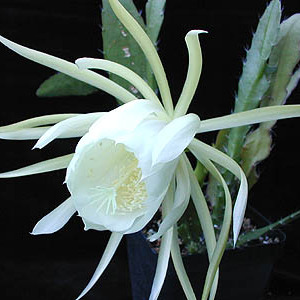Plants mostly epiphytic or rarely lithophytic shrubs, older stems often terete and somewhat woody near base, freely branching, erect, climbing or pendant, often with adventitious roots, usually spineless. Younger branches segmented, compressed, margins crenate, serrate, sometimes lobed or pinnatisect between the areoles, with prominent midline axis, glabrous, green, spines usually absent. Areoles only in sinuses along rib margins, c. 2–7 cm apart along rib, circular, woolly, occasionally hair-like bristles present. Spines usually absent from adult stems, present and terete on juvenile stems. Flowers borne laterally, solitary, salverform or funnelform, 10–30 cm long, usually nocturnal. Pericarpel with small scales, or rarely with hairs or bristles; hypanthium elongate with scales naked in the axils, abruptly dilated at the throat; limb broad. Outer tepals greenish (to yellow, white or red), often tinged red. Inner tepals white or yellow. Pericarpel scaly, spineless, spiny, or with bristles or hair-like spines. Perianth spreading to rotate. Outer tepals white, pale yellow or pink-tinged. Inner tepals pale yellow or white. Stamens numerous, inserted in hypanthium and around throat. Fruit fleshy, ovoid or obloid, with scales and areoles, often somewhat ridged, spineless, dehiscing along one side when mature, floral remnant persistent. Seeds reniform or ovate-reniform, testa glossy black, or dull when minutely pitted.
Succulent shrubby plants, usually epiphytic root-climbers; stems phylloid and jointed, usually of two intergrading types: the primary terete or subterete, usu-ally rooting, the secondary (flowering) flattened and leaf-like, lobed or undulate, the areoles marginal, naked or rarely minutely puberulent. Leaves lacking. Flow-ers nocturnal or ephemeral, sessile, borne singly at the areoles; perianth usually large, infundibuliform, the segments very numerous, the outer progressively shorter and less petaloid than the inner, reflexed or spreading, the tube relatively slender, usually longer than the segments, bearing usually few and sparse, inconspicuous bracts, usually without definite areoles; stamens very numerous, the filaments somewhat shorter than the perianth and united at progressively deeper levels to the hypanthium; ovary frequently cylindric-ovoid, with few to numerous naked or rarely minutely puberulent areoles; style filiform, somewhat longer than the stamens. Fruit a fleshy berry with numerous seeds.
Plants mostly epiphytic. Old stems woody at base, often terete; branches usually flattened and leaflike, or 3-winged, with stout midrib, margins crenate, coarsely serrate, or lacerate, sometimes horny. Areoles seated between crenations of stem margins, woolly when young, setose in juvenile growth. Leaves and spines absent. Flowers nocturnal, borne in lateral areoles, solitary, sessile, funnelform or salverform, usually large. Receptacle tube elongate, with scattered scales. Perianth spreading to rotate; segments usually linear-lanceolate. Petaloids white; outer ones often recurved, sometimes cream or pinkish. Stamens numerous; filaments inserted in receptacle tube and perianth throat; anthers exserted. Placentas parietal; style elongate; stigmas numerous, exserted, linear. Fruit green, red, or purplish, globose to cylindric, usually fleshy, with low ridges bearing scales, usually splitting along one side when ripe. Seeds numerous, ovate-reniform; testa glossy black, minutely wrinkled or spotted.


